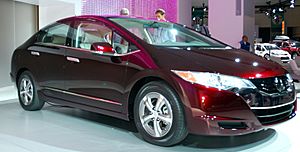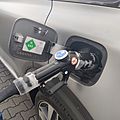Hydrogen car facts for kids
A hydrogen car is a vehicle that uses hydrogen as its fuel for motive power. A Hydrogen car does not have to be a car, it can be any transportation vehicle that uses hydrogen in a similar way, like an aircraft.
Contents
Hydrogen Energy
Hydrogen is the simplest and the most abundant element in the universe. Even though it's simple and there's so much of it, hydrogen does not occur naturally as a gas on the earth: it's always combined with other things. Hydrogen is high in energy, yet an engine that burns pure hydrogen produces almost no pollution.
Advantages of hydrogen energy
- Hydrogen comes from water by splitting it into oxygen and hydrogen, so supplies are almost limitless.
- As hydrogen is a diatomic molecule, the product of combustion is only water. Therefore, it does not produce the harmful gasses that gasoline and diesel cars produce, such as carbon dioxide.
- Hydrogen itself is not poisonous. Therefore, in case of outflow, hydrogen is safer than any other gas.
Disadvantages of hydrogen energy
- It's hard to store the large amount that is required to fuel a car
- Hydrogen is often taken from unrenewable resources, like fossil fuels.
The principles of Hydrogen Car
What is a Fuel Cell?
In principle, fuel cells are electrochemical devices like batteries that convert the chemical energy of a fuel directly and very efficiently into electricity (DC) and heat, thus doing away with combustion. Unlike a battery, a fuel cell does not run down or require recharging. It will produce energy in the form of electricity and heat as long as fuel is supplied.
What is the Principle?
A fuel cell consists of two electrodes sandwiched around an electrolyte. Oxygen passes over one electrode and hydrogen over the other, generating electricity water and heat. Layers of materials with distinct electrochemical properties are sandwiched together to form a single galvanic cell. At the heart lies a membrane that can only be crossed by charged molecules. Gas-permeable electrodes coated with a catalyst adhere to this membrane, adding a layer on either side. There electrodes are in turn connected to a device that can utilize electricity. Hydrogen gas flows into channels on one face of the cell and migrates through that electrode, while the same occurs with oxygen gas along the opposite electrode. Spurred by a catalyst, favorable chemistry causes the hydrogen to oxidize into hydrogen protons and give up its electrons to the neighboring electrode, which thereby becomes the anode. this buildup of negative charge then follows the path of least resistance via the external circuit to the other electrode. It is this flow of electrons through a circuit that creates elecricity.
Problem to solve for the practical use of hydrogen car
Most important problem involved in the practical use of hydrogen car is hydrogen storage materials. If it uses a fuel cell that generates electricity through reaction between hydrogen and oxygen, it does not matter. However, if method is that hydrogen is sprayed to internal-combustion engine, it does matter. Now hydrogen storage tank with highest possibility is method using metal hydride. Metal hydride is that reversible reaction between metal and hydrogen make new form of compound. Now Hydrogen storing technology using Hydrogen storage compound metal comes to practical use step in the side of technical, however, hydrogen storing capacity per weight is no match for demand of user, so this technology does not wide use yet. Therefore, that problem should be solved.
Images for kids
-
The Boeing Fuel Cell Demonstrator powered by a hydrogen fuel cell
-
The Hyundai Nexo is a hydrogen fuel cell-powered crossover SUV
-
The refueling of a Hydrogen-powered vehicle. The vehicle is a Hyundai Nexo. Note the condensation around the handle; this is because of the hydrogen gas expanding, causing the handle to freeze.
See also
 In Spanish: Vehículo de hidrógeno para niños
In Spanish: Vehículo de hidrógeno para niños











